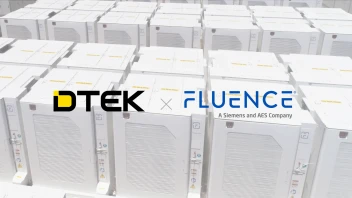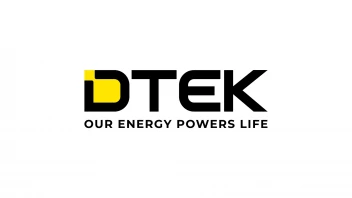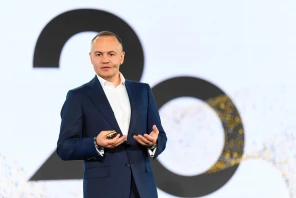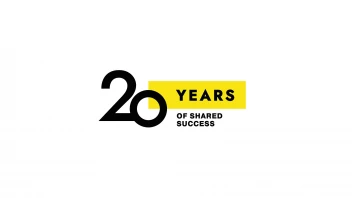UKRAINE / EU SYNCHRONIZATION HAPPENED 1 YEAR AGO. ENTSO-E WAS UKRAINE'S NATURAL CHOICE
Precisely one year ago, on March 16 a historic moment happened in the course of Ukraine’s power sector development. Ukraine joined the unified energy system of continental Europe, ENTSO-E, in an accelerated procedure. A year ahead of schedule and in the middle of russia’s large scale invasion.
In an interview for DTEK Group website DTEK CEO Maxim Timchenko described the synchronization processes, advantages obtained by Ukraine and perspectives for exporting Ukrainian green energy to the EU after the merger of the grid systems.
A year ago, Ukraine synchronized its energy system with those of Europe. Why was this important for Ukraine as a country and for Ukraine’s power sector in particular?
It was a live geopolitical choice. Ukraine is moving towards Europe, striving to become a trusted member of the European Union. For over a year now Ukraine’s Armed Forces are defending European values: freedom, democracy, the right to independence. Therefore, joining the unified energy system of continental Europe was vital. Especially in conditions of full-scale russian aggression.
I like to tell people that Ukraine already became a member of the EU in terms of energy in March 16, 2022! The synchronization of our energy systems laid the necessary foundation for further European integration processes to be built.
In my public speeches long before March 16, I consistently said that synchronization should become our national idea. Back then, I emphasized that joining ENTSO-E meant full participation of Ukraine and Ukrainian companies in the European energy market, the arrival of more Western companies and capital in Ukraine, greater competition and transparency, as well as disconnection from the power grid of russia and belarus.
Moving on from the geopolitical to the technical dimension of the issue, the connection of Ukraine to the ENTSO-E system determined Ukraine’s energy industry vector of development for decades to come.
If someone told you at the beginning of February 2022 that Ukraine’s power system would be able to function in an isolation mode for 21 days in the conditions of a full-scale war, would you believe it?
Now I know for sure that thanks to our power engineers, the Ukrainian energy system can demonstrate unbelievable resilience. Then, on February 24, 2022, four hours before the first russian attack, Ukraine disconnected from the power systems of russia and belarus in accordance with the technical protocol. The operation of our power system in an isolated mode was supposed to last for 3 days only. It was a test for Ukraine to prove that the energy system is stable and can function independently. As it turned out, that day Ukraine separated from russia and belarus forever. Instead, Ukraine’s power system managed to work in an isolation mode for 21 days - from February 24 to March 16.
In the conditions of war, destruction and constant shelling, energy workers managed to ensure the stability of our energy system. This is the merit of all market participants: Ministry of Energy, NEC "Ukrenergo", power producers. This was the result of real teamwork.
How did Ukraine prepare for synchronization with ENTSO-E and what was the role of DTEK in the process?
Ukraine has been systematically preparing for synchronization since 2017, since the Agreement on the conditions of the future unification (supposed to enter into force in 2023) had been signed. Over this time period, NEC "Ukrenergo", as the Ukrainian operator of the transmission system, conducted testing of power units at Ukrainian nuclear power plants, thermal power plants, thermal power plants and hydroelectric power stations.
DTEK TPPs were ready for the operation of the power system in isolation mode: we ensured the necessary coal production at our mines, a sufficient amount of it in the warehouses, conducted necessary repair campaigns. At that point reliable performance of maneuverable heat generation was of utmost importance for the stable operation of the Ukrainian power system.
On top of that, when operating in an isolation mode, Ukraine’s power system came at the verge of failing due to the shutdown of several Zaporizhjia NPP units, DTEK TPPs compensated for the lacking capacity. After receiving the central dispatcher command, DTEK put into operation 5 units at its TPPs to maintain permissible frequency indicator and prevent a system accident.
What practical benefits did Ukraine gain after joining ENTSO-E last year?
First and foremost, exporting Ukrainian electricity to Europe. Until October 2022, Ukraine had a significant surplus in the power system and actively earned essential funds from exports.
Secondly, Ukraine obtained its energy "safety measure" – insurance of aid in case of interruptions in the Ukrainian energy system. At the beginning of January 2023, Ukraine imported European electricity that helped balance the system at times of power shortages.
Ukraine is technically ready, but there is a certain limitation on the European side. Currently, the technical possibility of importing is 700 MW at any time of the day. But it can be twice as much. There are also projects to restore 750 KW interstate lines between Ukraine and the EU. Implementation of those projects will increase the technical capabilities of electricity transmission to 5-6 GW.
What is your vision of the EU’s and Ukraine’s electricity market joint development after the war is over?
Synchronization with ENTSO-E provided Ukraine with an opportunity to integrate into the regulatory environment of the EU and introduce a single electricity market with the EU. I am confident that after the victory of Ukraine, the joint electricity market will work at full capacity.
I am talking about the European producers and suppliers of electricity entering the Ukrainian market. This will contribute to increasing competition as well as building new market mechanisms. Integration into the European market will most definitely increase the investment flow into Ukraine’s energy industry in future.
Shaping the rules of Ukraine’s electricity market in accordance with the EU standards and norms will allow for the unification of day-ahead and intraday markets. This will simplify cross-border electricity trade and strengthen the stability of both the Ukrainian and European markets.
In addition, access to the infrastructural and production capacities of the European energy system will help speed up the development of renewable energy projects in Ukraine. In this context, I would like to remind you that DTEK Group presented the "30 to 2030" initiative at the last WEF 2022 in Davos. The goal of the "30 to 2030" initiative is to have 30 GW of renewable energy capacity in Ukraine by 2030, which will become an important part of Ukraine's post-war reconstruction plan and the main driving force behind the development of the Ukrainian economy. 30 GW of RES would allow Ukraine to achieve a 50% share of RES in the capacity structure. 15 GW of clean energy could be exported to the EU in the form of electricity and clean hydrogen.
Thus, Ukraine can become the main exporter of clean energy to the EU and make a major contribution to the post-war energy security system of Europe. We appeal to all international companies to join the coalition of those willing to rebuild the ecological future of Ukraine.







